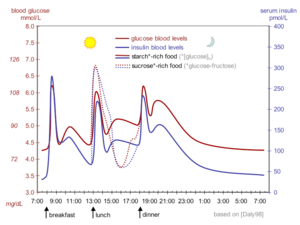Blood sugar level facts for kids
The blood sugar level, blood sugar concentration, blood glucose level, or glycemia, is the measure of glucose concentrated in the blood. It is one of the most important variables that the organism regulates (homeostasis) in the internal environment. The term "homeostasis" was first proposed by the French physiologist Claude Bernard (1813-1878).
Characteristics
In vertebrates, the concentration of free glucose in the blood (glycemia) varies during the course of the day. Upward variations are due to food intake and subsequent absorption. Glucose levels are usually lowest in the morning, before the first meal of the day, and rise after meals for an hour or two by a few millimoles.
For a 70 kg (154 lb) human, approximately four grams of dissolved glucose is maintained in the blood plasma at all times. Glucose is also stored in skeletal muscle and liver cells in the form of glycogen; in fasting individuals, blood glucose is maintained at a constant level by using glycogen stores in the liver and skeletal muscle. Glucose can be transported from the intestines or liver to other tissues in the body via the bloodstream. Cellular glucose uptake is primarily regulated by insulin, a hormone produced in the pancreas.
In humans, properly maintained glucose levels are necessary for normal function in a number of tissues, including the human brain, which consumes approximately 60% of blood glucose in fasting, sedentary individuals. A persistent elevation in blood glucose leads to glucose toxicity, which contributes to cell dysfunction and the pathology grouped together as complications of diabetes.
Measure
A blood sample is taken at least eight hours after the last meal. It is the first test performed to diagnose carbohydrate metabolism disorders, especially diabetes mellitus and hypoglycemia. After eating, it is normal for blood glucose levels to rise during the first two hours.
Blood glucose levels are expressed in the following units:
- milligrams of glucose per deciliter (mg/dL) or
- millimoles of glucose per liter (mmol/L).2
Normal values
During fasting, normal glucose levels range between 70 and 100 mg/dL (3.9 and 5.6 mmol/L) (normoglycemia). When blood glucose level is below this threshold, it is referred to as hypoglycemia. Symptoms may include lethargy, impaired mental functioning; irritability; shaking, twitching, weakness in arm and leg muscles; pale complexion; sweating; loss of consciousness.
When blood glucose level is between 100 and 125 mg/dL (6.9 mmol/l) it is called impaired fasting glucose, and when it exceeds 126 mg/dL it is called hyperglycemia. Hyperglycemia is the most common indicator of diabetes, which occurs as a result of insulin deficiency in the case of type I diabetes or insulin resistance in the case of type II diabetes. If blood sugar levels remain too high the body suppresses appetite over the short term. Long-term hyperglycemia causes many health problems including heart disease, cancer, eye, kidney, and nerve damage.
Many hormones are related to glucose metabolism, including insulin and glucagon (both secreted by the pancreas), adrenaline (of adrenal origin), glucocorticoids and steroid hormones.
Clinical correlation
The fasting blood glucose level, which is measured after a fast of 8 hours, is the most commonly used indication of overall glucose homeostasis, largely because disturbing events such as food intake are avoided. Conditions affecting glucose levels are shown in the table below. Abnormalities in these test results are due to problems in the multiple control mechanism of glucose regulation.
The metabolic response to a carbohydrate challenge is conveniently assessed by a postprandial glucose level drawn 2 hours after a meal or a glucose load. In addition, the glucose tolerance test, consisting of several timed measurements after a standardized amount of oral glucose intake, is used to aid in the diagnosis of diabetes.
Error rates for blood glucose measurements systems vary, depending on laboratories, and on the methods used. Colorimetry techniques can be biased by color changes in test strips (from airborne or finger-borne contamination, perhaps) or interference (e.g., tinting contaminants) with light source or the light sensor. Electrical techniques are less susceptible to these errors, though not to others. In home use, the most important issue is not accuracy, but trend. Thus if a meter / test strip system is consistently wrong by 10%, there will be little consequence, as long as changes (e.g., due to exercise or medication adjustments) are properly tracked. In the US, home use blood test meters must be approved by the federal Food and Drug Administration before they can be sold.
Finally, there are several influences on blood glucose level aside from food intake. Infection, for instance, tends to change blood glucose levels, as does stress either physical or psychological. Exercise, especially if prolonged or long after the most recent meal, will have an effect as well. In the typical person, maintenance of blood glucose at near constant levels will nevertheless be quite effective.
See also
 In Spanish: Glucemia para niños
In Spanish: Glucemia para niños
- Blood glucose monitoring
- Glycemic index
- Saccharide recognition by boronic acids


